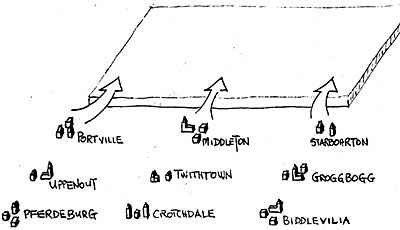
Instead of having troops coming on the field exactly in the order in which one desires, one may dice for the order of entry. This article presents a variation on this theme, one in which the order, the time, and place of entry is randomized.
The map shows the table and the three towns through which units must pass to come on the field: Portville on the left, Middleton in the center, and Starboarton on the right. Once a unit arrives in one of these towns, its leading stand is placed on the table at the appropriate location on the baseline and on the next turn, the unit marches onto the field.
The map also shows six other towns through which the units will wander, seeking to find Portville, Middleton, or Starboarton. The road system is not laid out, because the troops will "dice" their way along the highways in accordance with the following table:
| LOCATION | DESTINATION | ||
|---|---|---|---|
| 01-33 | 34-66 | 67-100 | |
| Twithtown | Groggbogg | Biddlevilia | Uppenout |
| Biddlevilia | Crotchdale | Groggbogg | Twithtown |
| Groggbogg | Twithtown | Biddlevilia | Pferdeburg |
| Uppenout | Biddlevilia | Portville | Middleton |
| Crotchdale | Twithtown | Middleton | Starboarton |
| Pferdeburg | Starboarton | Groggbogg | Portville |
An astute analyst will note that this table sets out the six towns that are listed in the left hand column in two tiers of three towns each:
- The first tier consists of Twithtown, Biddlevilia and
Groggbogg. A unit in one of these towns has a 66% chance,
when dicing to find out where it appears next, of again
finding itself in another one of these first tier towns. It
has a 34% chance of winding up where it wants to go, that is,
in one of the second tier towns.
The second tier consists of Uppenout, Crotchdale and Pferdeburg. Here, a unit dicing for its next location has a 66% chance of joyfully finding itself in one of the three entry towns, i.e., Portville, Middleton, or Starboarton, The remaining 34%, however, will cause the unhappy unit to find itself back in one of the first tier towns, and its wanderings continue.
In an ACW game we set up at a PW meeting using this layout, the entire attacking force, several brigades, was permitted to enter the field on Turn 1. The defenders had only one regiment on the table, holding a small fortification.
All the rest of the defending force, including the sister regiment of the lone defenders, was spread out amongst the first tier towns, offboard. Twice each turn, an offboard "strategic" movement phase occurred, and each reserve brigade diced for its next location, hoping to hit the 34% window, find the right road, and end up in a second tier town.
There were some five offboard brigades, and, true to form, the cavalry was the first reserve unit to find its way through the first and second tiers and galloped onto the field in the center of the baseline.
All the reserve units eventually found their way to the battlefield. Some, of course, had more difficulty than others, consistently taking wrong roads, going north when they should have gone south, turning left instead of right, and bouncing back and forth between the first and second tier towns ("Biddlevilia? Biddlevilia?", said the Brigade Commander. "Haven't we been here before?").
The way the chart is set up, if a unit is placed in a first tier town, the chance of its successfully wending its way to an entry town the first time through, is:
- Chance to get to second tier (1/3)
x Chance to get to entry town (2/3) = 22%
Depending upon the scenario and the desires of the participants, the table percentage values may easily be altered to suit the game to increase the probability of a unit's early appearance. Conversely, if one is inherently mean and nasty, a three tier system may be incorporated.
Back to PW Review November 1988 Table of Contents
Back to PW Review List of Issues
Back to MagWeb Master Magazine List
© Copyright 1988 Wally Simon
This article appears in MagWeb (Magazine Web) on the Internet World Wide Web.
Other articles from military history and related magazines are available at http://www.magweb.com